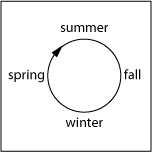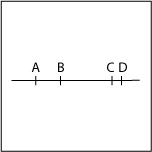1.4.1. Time
Definition
Time quantifies or measures the interval between events, or the duration of events and has only a "forward direction". Time features different granularity e.g. seconds, minutes, hours, days, months, years, centuries, etc. (Neumann 2005)
Realtime Clock (Adobe)Conceptualizing and Modeling Time
(1998, p. 45) mainly distinguishes between linear and cyclic time:
- Cyclic time is used in case of reoccuring events and needs to be brought into relation with an absolute.
- Linear time scale is used for accurate calculation against an origin.
 Cyclic Time according to Frank 1998 Cyclic Time according to Frank 1998 |
 Linear Time according to Frank 1998 Linear Time according to Frank 1998 |
Depending on the accuracy of time observations and measurement one can subdivide the two time types into:
 Ordinal Time: time points are the
basic objects to describe the time an event happened (Frank 1998); there is no duration of the event and the order of
the time is important.
Ordinal Time: time points are the
basic objects to describe the time an event happened (Frank 1998); there is no duration of the event and the order of
the time is important.
 Interval Time: events are measured
on an interval scale. The level of accuracy and precision is defined by its
granularity, the smallest time unit (e.g. second, hour, day, year) used in
measuring time (Neumann 2005).
Interval Time: events are measured
on an interval scale. The level of accuracy and precision is defined by its
granularity, the smallest time unit (e.g. second, hour, day, year) used in
measuring time (Neumann 2005).
 Ordinal time scale Ordinal time scale |
 Interval time scale Interval time scale |
Visualisation of Time
Time cannot be seen and visualised directly, but only its effects such as the changes in the spatial and thematic dimensions. It is only natural, therefore, that temporal controls are usually tied to visualisation, serving both navigation and visualisation purposes. Depending on the topology, range and granularity of the time, linear, circular or tree representations and controls are more suitable. (Neumann 2005)
The different temporal navigation elements are presented in the next chapter.
Temporal navigation is always combined with a theme. The question "What has happened when?" is the most important question in temporal navigation. Therefore, temporal navigation acts like thematic navigation but instead of the theme you select or define the time.
